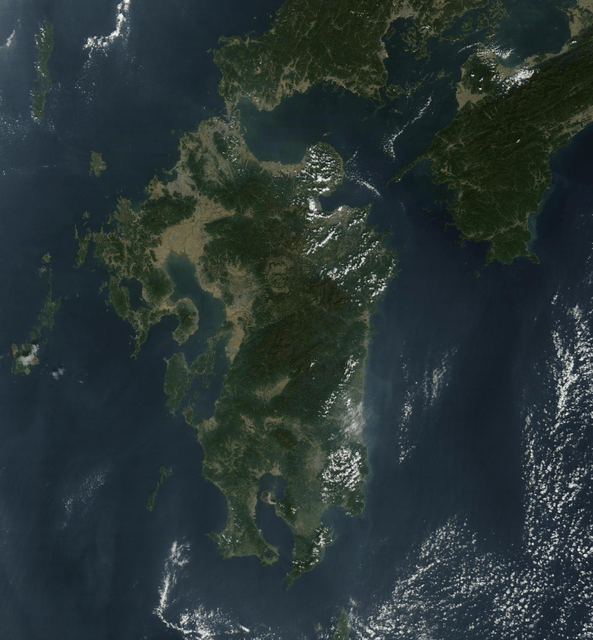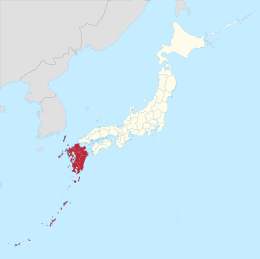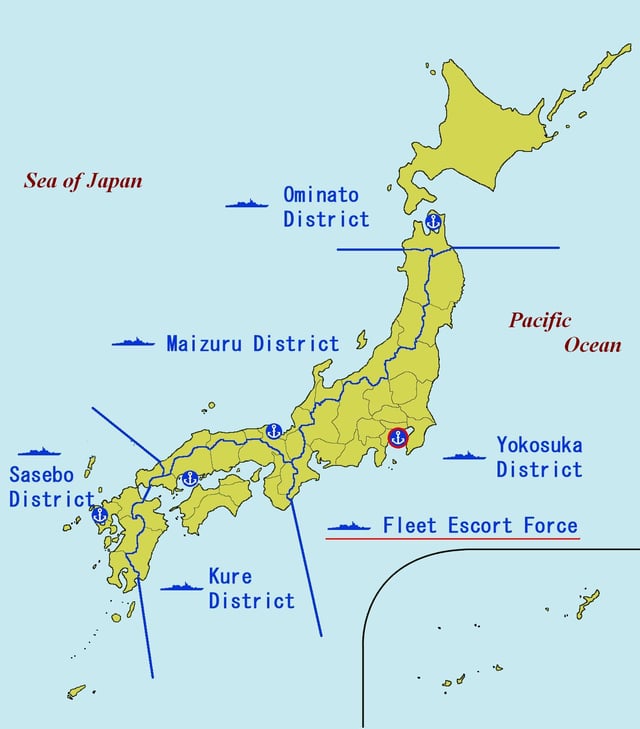Kyushu

Kyushu

| Native name: 九州 | |
|---|---|
 Kyushu region of Japan and the current prefectures on the island of Kyushu | |
| Geography | |
| Location | East Asia |
| Archipelago | Japanese Archipelago |
| Area | 36,782 km2(14,202 sq mi) |
| Area rank | 37th |
| Coastline | 12,221 km (7,593.8 mi) |
| Highest elevation | 1,791 m (5,876 ft) |
| Highest point | Mount Kujū[1] |
| Administration | |
| Prefectures | |
| Largest settlement | Fukuoka |
| Demographics | |
| Population | 12,970,479 (2016) |
| Pop. density | 307.13 /km2(795.46 /sq mi) |
| Ethnic groups | Japanese |
Kyushu (九州, Kyūshū, pronounced [kʲɯꜜːɕɯː] (listen); literally "Nine Provinces") is the third largest island of Japan's five main islands.[2][3] Its alternative ancient names include Kyūkoku (九国, "Nine Countries"), Chinzei (鎮西, "West of the Pacified Area"), and Tsukushi-no-shima (筑紫島, "Island of Tsukushi"). The historical regional name Saikaidō (西海道, lit. West Sea Circuit) referred to Kyushu and its surrounding islands.
In the 8th-century Taihō Code reforms, Dazaifu was established as a special administrative term for the region.[4]
As of 2016, Kyushu has a population of 12,970,479 and covers 36,782 square kilometres (14,202 sq mi).[5]
| Native name: 九州 | |
|---|---|
 Kyushu region of Japan and the current prefectures on the island of Kyushu | |
| Geography | |
| Location | East Asia |
| Archipelago | Japanese Archipelago |
| Area | 36,782 km2(14,202 sq mi) |
| Area rank | 37th |
| Coastline | 12,221 km (7,593.8 mi) |
| Highest elevation | 1,791 m (5,876 ft) |
| Highest point | Mount Kujū[1] |
| Administration | |
| Prefectures | |
| Largest settlement | Fukuoka |
| Demographics | |
| Population | 12,970,479 (2016) |
| Pop. density | 307.13 /km2(795.46 /sq mi) |
| Ethnic groups | Japanese |
Geography
The island is mountainous, and Japan's most active volcano, Mt Aso at 1,591 metres (5,220 ft), is on Kyushu. There are many other signs of tectonic activity, including numerous areas of hot springs. The most famous of these are in Beppu, on the east shore, and around Mt. Aso, in central Kyushu. The island is separated from Honshu by the Kanmon Straits. Kyushu is the nearest to the Asian continent which made it the gateway to Japan.[6]
The name Kyūshū comes from the nine ancient provinces of Saikaidō situated on the island: Chikuzen, Chikugo, Hizen, Higo, Buzen, Bungo, Hyūga, Osumi, and Satsuma.[7]
Today's Kyushu Region (九州地方, Kyūshū-chihō) is a politically defined region that consists of the seven prefectures on the island of Kyushu (which also includes the former Tsushima and Iki as part of Nagasaki), plus Okinawa Prefecture to the south:
Northern Kyushu Fukuoka Prefecture Kumamoto Prefecture Nagasaki Prefecture Ōita Prefecture Saga Prefecture
Southern Kyushu Kagoshima Prefecture Miyazaki Prefecture Okinawa Prefecture
Demography
Kyushu comprises 10.3 percent of the entire population of Japan.[8] Most of Kyushu's population is concentrated along the northwest, in the cities of Fukuoka and Kitakyushu, with population corridors stretching southwest into Sasebo and Nagasaki and south into Kumamoto and Kagoshima. Excepting Oita and Miyazaki cities, the eastern seaboard shows a general decline in population.
Kyushu is described as a stronghold of the LDP political party.[9]
- Designated cities
Fukuoka (population: 1,588,924)
Kitakyushu (population: 940,978)
Kumamoto (population: 738,907)
- Core cities
Kagoshima
Ōita
Nagasaki
Miyazaki
Naha
Kurume
Sasebo
Saga
Economy and environment

Map of Kyushu region with prefectures

JMSDF District Forces, including the Sasebo District Force
Parts of Kyushu have a subtropical climate, particularly Miyazaki prefecture and Kagoshima prefecture. Major agricultural products are rice, tea, tobacco, sweet potatoes, and soy; silk is also widely produced. The island is noted for various types of porcelain, including Arita, Imari, Satsuma, and Karatsu. Heavy industry is concentrated in the north around Fukuoka, Kitakyushu, Nagasaki, and Oita and includes chemicals, automobiles, semiconductors, and metal processing.
In 2010, the graduate employment rate in the region was the lowest nationwide, at 88.9%.[10]
Besides the volcanic area of the south, there are significant mud hot springs in the northern part of the island, around Beppu. These springs are the site of occurrence of certain extremophile micro-organisms, that are capable of surviving in extremely hot environments.[11]
Education
Major universities and colleges in Kyushu:
National universities Kyushu University – One of seven former "Imperial Universities" Kyushu Institute of Technology Saga University Nagasaki University Kumamoto University Fukuoka University of Education Oita University Miyazaki University Kagoshima University National Institute of Fitness and Sports in Kanoya University of the Ryukyus
Universities run by local governments University of Kitakyushu Kyushu Dental College Fukuoka Women's University Fukuoka Prefectural University Nagasaki Prefectural University Oita University of Nursing and Health Sciences Prefectural University of Kumamoto Miyazaki Municipal University Miyazaki Prefectural Nursing University Okinawa Prefectural University of Arts
Major private universities Fukuoka University – University with the largest number of students in Kyushu Kumamoto Gakuen University Ritsumeikan Asia Pacific University Seinan Gakuin University Kyushu Sangyo University – Baseball team won the Japanese National Championship in 2005 University of Occupational and Environmental Health Kurume University
Transportation
The island is linked to the larger island of Honshu by the Kanmon Tunnels, which carry both the San'yō Shinkansen and non-Shinkansen trains of the Kyushu Railway Company, as well as vehicular, pedestrian, and bicycle traffic. The Kanmon Bridge also connects the island with Honshu. Railways on the island are operated by the Kyushu Railway Company, and Nishitetsu Railway.
See also
Japanese archipelago
Geography of Japan
List of regions in Japan
Northern Kyushu, Southern Kyushu
Azumi people, an ancient group of people who inhabited parts of northern Kyūshū
Group Kyushu
Western Army (Japan)
United States Fleet Activities Sasebo
Hoenn, a fictional region in the Pokémon franchise which is based on Kyushu
Kanmonkyo Bridge, that connects Kyūshū with Honshū
Kyushu National Museum
Kyushu dialects, Hichiku dialect, Hōnichi dialect and Kagoshima dialect